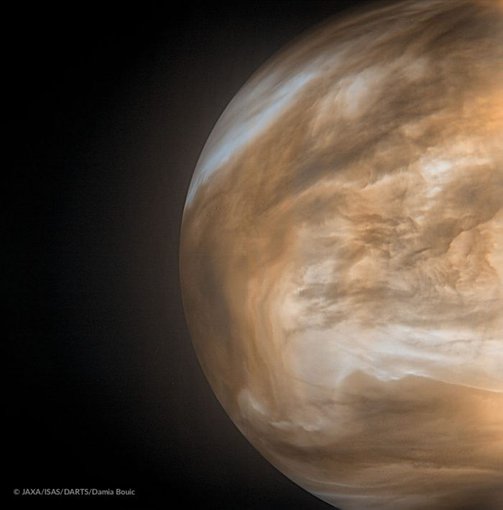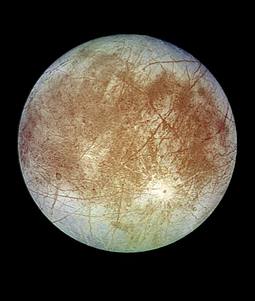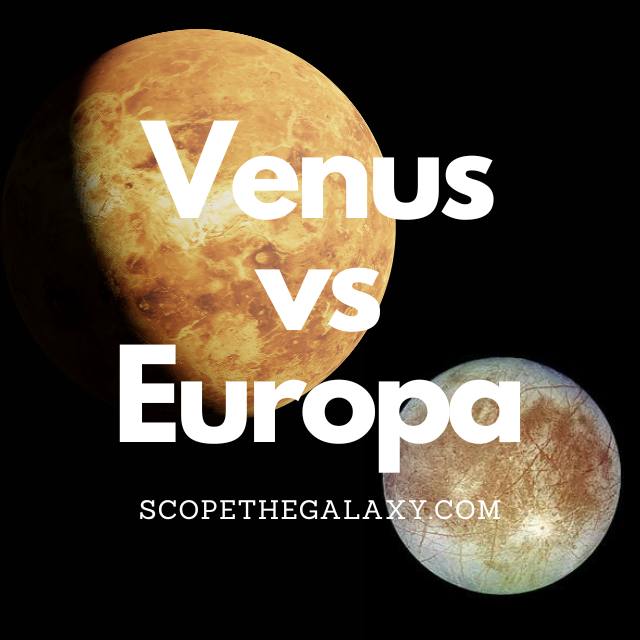*This post may contain affiliate links. This means we may make a commission if you purchase an item using one of our links*
The main differences between Venus and Europa is that Venus is the hottest and brightest planet in our solar system and the 6th biggest planet whereas Europa is the most luminous moon in our solar system, orbits Jupiter and is the 6th largest moon in our solar system to boot.
There are a variety of other differences between Venus and Europa too so, continue reading if you’re looking for a more in depth look at each celestial body along with their similar and distinct features.
What Is The Planet Venus?
Table of Contents

Venus is the 2nd closest planet to the Sun and is often regarded as Earth’s sister planet. It’s very close to our Earth in size where its diameter is 12,104km. This is just over 600km less wide than our home planet.
Unlike all the planets further outside the Sun’s orbit, Venus and even mercury have no moons orbiting it. The most probable reason for this is due to its closer proximity to it, which means that smaller objects orbit the Sun as opposed to Venus.
Venus is also the hottest planet in our solar system where its surface temperature is 475 degrees Celsius. This is due to a number of factors, like the thicker atmosphere, close proximity to Sun, the reasons for which have been explained in more detail here.
It’s core is hot too, similar to that of the ice giants and Earth, where it stands at 5,200 degrees Celsius.
As a result of this thicker atmosphere, Venus is also able to reflect a lot more of the light the Sun projects at it, making it both the hottest and brightness planet in our solar system. This is why for the longest time, and even till this day Venus is often referred to as the morning or evening star.
The thicker atmosphere is mostly compromised of carbon dioxide, and thick clouds of sulfuric acid. This does result sulfuric acid rain on the planets surface, which of course is very corrosive.
Being so close to the Sun also mean its orbital cycle is much shorter. It takes Venus 225 days to complete a full cycle, on the contrary a single day is actually longer than this where it takes around 243 days for a full rotation around its axis.
This is partially down to its distance from the Sun and the thick atmosphere surrounding this terrestrial planet. The axial tilt on Venus is also different from the other planets in our solar system where it is practically straight at 3 degrees.
All in all this is certainly one of the most interesting planets in our solar system and in many peoples eyes, could very well have supported life in the past based on how close its shape and size is to that of Earth.
What Is The Moon Europa?

Europa is the smallest of the Galilean moons, first discovered on 8th January 1610. The surface of this icy world is frozen, but scientists believe a watery ocean could lie beneath the surface. And in 2012, researchers found a possible water plume in the Southern polar region of Europa.
This research is yet to be confirmed; still, it gives us reasonable grounds to hypothesize that water could exist on this icy moon.
Estimates place Europa at around 4.5 billion years old (the same age as its planet, Jupiter), and its average distance from the Sun is approximately 780 million km.
It has a diameter of 3,121.6km, which makes it larger than Pluto but smaller than the Earth’s moon, and the maximum temperature is a chilly -160 degrees Celsius. In regards to mass, it measures in around 4.8 × 10^22 kg.
Europa takes three-and-a-half days to orbit its planet at an average distance of 670,900km, and it is tidally locked, meaning the same side of the moon always faces Jupiter.
Among the fascinating features of this ice moon is its incredibly reflective nature. The icy crust of this body provides a light reflectivity of 0.64 – the highest of any moon in the solar system.
Data from the Galileo spacecraft suggests that Europa is composed of an iron core, rocky mantle, and silicate rock (a similar composition to Earth).
The moon’s surface is covered in cracks, which many theorize could result from tidal currents beneath the surface. It is this potential of water – and of life – that keeps astronomers so interested in this moon.
Europa might be small, but astronomers estimate it holds two to three times more water than the Earth. In addition, this moon possesses the essential elements for life, such as carbon, oxygen, hydrogen, and nitrogen.
There may be no solar energy on this moon, but hydrothermal vents could provide energy, and tidal heating from Jupiter could provide a heat source and keep the moon stable enough for life to form. In addition, the liquid ocean is well protected from radiation from thick, icy surfaces.
How Are Venus And Europa Different?
The similarities between Venus and Europa include the following:
- Both have a hotter central core.
- Both are a spherical in shape.
- Both are terrestrial based celestial bodies
- Both have an atmosphere and a rocky surface.
- Neither are tidally locked to the Sun.
- Both have no rings surrounding them.
- Neither have tectonic plates.
- Neither have other natural satellites orbiting them.
Differences Between Venus And Europa
In regards to the differences between the two, they include the following:
- Europa is the brightest moon in our solar system with an albedo of 0.64 but Venus is the brightest celestial body in our solar system (besides the Sun) with an albedo rating of 0.90.
- Venus is the hottest celestial entity in our solar system (besides the Sun) where it has an average temperature of 475 degrees Celsius whilst Europa’s average is -160 degrees Celsius.
- Venus has the thickest atmosphere amongst the terrestrial entities in our solar system where it is 90 times thicker than Earth’s whilst Europa’s atmosphere is virtually non-existent.
- Europa’s surface is made mostly of water ice whilst Venus’ surface consists of craters and volcanoes.
- Venus is the bigger of the two where it has a diameter of 12,104km whereas Europa’s diameter is 3,121.6km,
- Europa is tidally locked to Jupiter whereas Venus is not tidally locked to anything.
- It takes Venus 225 days to orbit the Sun and 12 years for Europa to orbit the Suh however, as it is tidally locked to Jupiter and is a natural satellite, it also takes it 3.55 days to orbit the gas giant.
- Venus has an axial tilt of 3 degrees whilst Europa’s axial tilt is 0.1 degrees.
- Venus is the bigger of the two with a mass of 4.867 × 10^24 kg whereas Europa’s mass is4.8 × 10^22 kg.
- Europa’s gravitational strength is 1.315 m/s² whilst Venus has a gravitational strength of 8.87 m/s².
- In regards to their density Venus has a density of 5.24 g/cm³ whilst Europa’s density is 3.01 g/cm³.
- Venus orbits the Sun in a pattern that is nearly circular whilst Europa orbits Jupiter elliptically.
Summary
Even if Jupiter’s Galilean moon Europa and Venus the 2nd biggest terrestrial planet in our solar system do share the odd few commonalities such as their lack of tectonic plates, lack of moons and of course their general composition of a rock planet with an atmosphere, they still differ from each other a lot more.
Whether it be in size, luminosity, temperature, thickness of their atmosphere and more, Venus and Europa are very different from one another, after all their overall functions aren’t the same as one is a planet and the other a natural satellite that orbits another planet.

